War crime
A war crime is an act that constitutes a serious violation of the laws of war that gives rise to individual criminal responsibility.[1] Examples of crimes include intentionally killing civilians or prisoners, torturing, destroying civilian property, taking hostages, performing a perfidy, raping, using child soldiers, pillaging, declaring that no quarter will be given, and seriously violating the principles of distinction, proportionality, and military necessity.
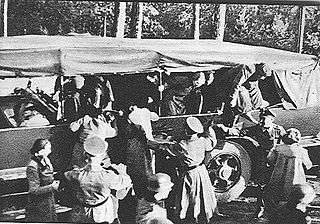
The concept of war crimes emerged at the turn of the twentieth century when the body of customary international law applicable to warfare between sovereign states was codified. Such codification occurred at the national level, such as with the publication of the Lieber Code in the United States, and at the international level with the adoption of the treaties during the Hague Conventions of 1899 and 1907. Moreover, trials in national courts during this period further helped clarify the law.[1] Following the end of World War II, major developments in the law occurred. Numerous trials of Axis war criminals established the Nuremberg principles, such as notion that war crimes constituted crimes defined by international law. Additionally, the Geneva Conventions in 1949 defined new war crimes and established that states could exercise universal jurisdiction over such crimes.[1] In the late 20th century and early 21st century, following the creation of several international courts, additional categories of war crimes applicable to armed conflicts other than those between states, such as civil wars, were defined.[1]
History

Early examples
The trial of Peter von Hagenbach by an ad hoc tribunal of the Holy Roman Empire in 1474 was the first "international" war crimes trial, and also of command responsibility.[2][3] He was convicted and beheaded for crimes that "he as a knight was deemed to have a duty to prevent", although he had argued that he was "just following orders".
In 1865, Henry Wirz, a Confederate States Army officer, was held accountable by a military tribunal and hanged for the appalling conditions at Andersonville Prison, where many Union prisoners of war died during the American Civil War.
Hague Conventions
The Hague Conventions were international treaties negotiated at the First and Second Peace Conferences at The Hague, Netherlands, in 1899 and 1907, respectively, and were, along with the Geneva Conventions, among the first formal statements of the laws of war and war crimes in the nascent body of secular international law.
Geneva Conventions
The Geneva Conventions are four related treaties adopted and continuously expanded from 1864 to 1949 that represent a legal basis and framework for the conduct of war under international law. Every single member state of the United Nations has currently ratified the conventions, which are universally accepted as customary international law, applicable to every situation of armed conflict in the world. However, the Additional Protocols to the Geneva Conventions adopted in 1977 containing the most pertinent, detailed and comprehensive protections of international humanitarian law for persons and objects in modern warfare are still not ratified by a number of States continuously engaged in armed conflicts, namely the United States, Israel, India, Pakistan, Iraq, Iran, and others. Accordingly, states retain different codes and values with regard to wartime conduct. Some signatories have routinely violated the Geneva Conventions in a way which either uses the ambiguities of law or political maneuvering to sidestep the laws' formalities and principles.
Three conventions were revised and expanded with the fourth one added in 1949:
- First Geneva Convention for the Amelioration of the Condition of the Wounded and Sick in Armed Forces in the Field (Convention for the Amelioration of the Condition of the Wounded and Sick in Armed Forces in the Field was adopted in 1864, significantly revised and replaced by the 1906 version,[4] the 1929 version, and later the First Geneva Convention of 1949[5]).
- Second Geneva Convention for the Amelioration of the Condition of Wounded, Sick and Shipwrecked Members of Armed Forces at Sea (Convention for the Amelioration of the Condition of Wounded, Sick and Shipwrecked Members of Armed Forces at Sea was adopted in 1906,[6] significantly revised and replaced by the Second Geneva Convention of 1949).
- Third Geneva Convention relative to the Treatment of Prisoners of War (Convention relative to the Treatment of Prisoners of War was adopted in 1929, significantly revised and replaced by the Third Geneva Convention of 1949).
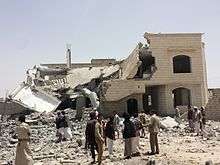 HRW wrote that the Saudi Arabian-led military intervention in Yemen that began on March 26, 2015 had conducted airstrikes in apparent violation of the laws of war.[7]
HRW wrote that the Saudi Arabian-led military intervention in Yemen that began on March 26, 2015 had conducted airstrikes in apparent violation of the laws of war.[7] - Fourth Geneva Convention relative to the Protection of Civilian Persons in Time of War (first adopted in 1949, based on parts of the 1907 Hague Convention IV).
Two Additional Protocols were adopted in 1977 with the third one added in 2005, completing and updating the Geneva Conventions:
- Protocol I (1977) relating to the Protection of Victims of International Armed Conflicts.
- Protocol II (1977) relating to the Protection of Victims of Non-International Armed Conflicts.
- Protocol III (2005) relating to the Adoption of an Additional Distinctive Emblem.
Leipzig War Crimes Trial
A small number of German military personnel of the First World War were tried in 1921 by the German Supreme Court for alleged war crimes.
London Charter / Nuremberg Trials 1945
The modern concept of war crime was further developed under the auspices of the Nuremberg Trials based on the definition in the London Charter that was published on August 8, 1945. (Also see Nuremberg Principles.) Along with war crimes the charter also defined crimes against peace and crimes against humanity, which are often committed during wars and in concert with war crimes.
International Military Tribunal for the Far East 1946
Also known as the Tokyo Trial, the Tokyo War Crimes Tribunal or simply as the Tribunal, it was convened on May 3, 1946 to try the leaders of the Empire of Japan for three types of crimes: "Class A" (crimes against peace), "Class B" (war crimes), and "Class C" (crimes against humanity), committed during World War II.
International Criminal Court 2002
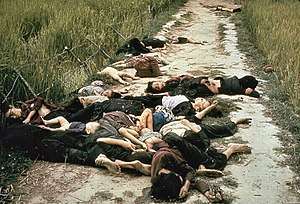
On July 1, 2002, the International Criminal Court, a treaty-based court located in The Hague, came into being for the prosecution of war crimes committed on or after that date. Several nations, most notably the United States, China, Russia, and Israel, have criticized the court. The United States still participates as an observer. Article 12 of the Rome Statute provides jurisdiction over the citizens of non-contracting states in the event that they are accused of committing crimes in the territory of one of the state parties.[8]
War crimes are defined in the statute that established the International Criminal Court, which includes:
- Grave breaches of the Geneva Conventions, such as:
- Willful killing, or causing great suffering or serious injury to body or health
- Torture or inhumane treatment
- Unlawful wanton destruction or appropriation of property
- Forcing a prisoner of war to serve in the forces of a hostile power
- Depriving a prisoner of war of a fair trial
- Unlawful deportation, confinement or transfer
- Taking hostages
- Directing attacks against civilians
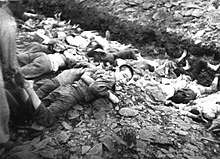 Bodo League massacre during the Korean War in 1950
Bodo League massacre during the Korean War in 1950 - Directing attacks against humanitarian workers or UN peacekeepers
- Killing a surrendered combatant
- Misusing a flag of truce
- Settlement of occupied territory
- Deportation of inhabitants of occupied territory
- Using poison weapons
- Using civilians as shields
- Using child soldiers
- Firing upon a Combat Medic with clear insignia.
- The following acts as part of a non-international conflict:
- Murder, cruel or degrading treatment and torture
- Directing attacks against civilians, humanitarian workers or UN peacekeepers
- The following acts as part of an international conflict:
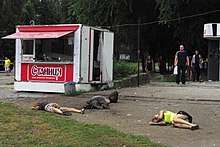 Civilians killed in shelling in eastern Ukraine. According to the HRW report, "The use of indiscriminate rockets in populated areas violates international humanitarian law, or the laws of war, and may amount to war crimes."[9]
Civilians killed in shelling in eastern Ukraine. According to the HRW report, "The use of indiscriminate rockets in populated areas violates international humanitarian law, or the laws of war, and may amount to war crimes."[9]- Taking hostages
- Summary execution
- Pillage
- Rape, sexual slavery, forced prostitution or forced pregnancy
However the court only has jurisdiction over these crimes where they are "part of a plan or policy or as part of a large-scale commission of such crimes".[10]
Prominent indictees
Heads of state and government

To date, the present and former heads of state and heads of government that have been charged with war crimes include:
- German Großadmiral and President Karl Dönitz and Japanese Prime Ministers and Generals Hideki Tōjō and Kuniaki Koiso in the aftermath of World War II.
- Former Serbian President Slobodan Milošević was brought to trial charges with, genocide, crimes against humanity, and war crimes in three republics. The tribunal found the prosecution had according to its rules and procedures; enough evidence was tailored, prior to the defense presentation, that, "a reasonable trier of fact, could conclude, the accused was responsible for the crimes charged." This pertaining to superior responsibility, for the Bosnia and Croatia indictment's, and individual responsibility, for the Kosovo indictment. No conviction was established however, as he died in custody in 2006, before the trial could be concluded.[11]
- Former Liberian President Charles G. Taylor was also brought to The Hague charged with war crimes; his trial stretched from 2007 to March 2011. He was convicted in April 2012 of Aiding and Abbetting and planning the commission of Crimes against Humanity, committed during the war under individual and command responsibility.[12]
- Former Bosnian Serb President Radovan Karadžić was arrested in Belgrade on July 18, 2008 and brought before Belgrade's War Crimes Court a few days after. He was extradited to the Netherlands, and is currently in The Hague, in the custody of the International Criminal Tribunal for the former Yugoslavia. The trial began in 2010. On March 24, 2016, he was found guilty of genocide in Srebrenica, war crimes and crimes against humanity, 10 of the 11 charges in total, and sentenced to 40 years' imprisonment.[13][14] He was sentenced to life on appeal.[15]
- Omar al-Bashir, former head of state of Sudan, is charged with three counts of genocide, crimes against humanity and other war crimes regarding the 2003– War in the Darfur region of Sudan. The first head of state charged with genocide by the International Criminal Court with current warrants of arrest actions in Darfur.
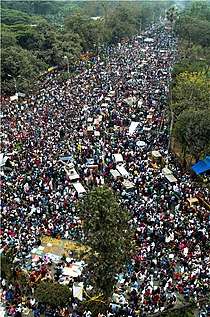 2013 Shahbag protests demanding the death penalty for the war criminals of the 1971 Bangladesh Liberation War
2013 Shahbag protests demanding the death penalty for the war criminals of the 1971 Bangladesh Liberation War - Former Libyan leader Muammar Gaddafi was indicted for allegedly ordering the killings of protesters and civilians and Crimes against Humanity, during the 2011 Libyan civil war, however he was killed before he could stand trial in October 2011.
Other prominent indictees
- Yoshijirō Umezu, a general in the Imperial Japanese Army
- Seishirō Itagaki, War minister of the Empire of Japan
- Hermann Göring, Commander in Chief of the Luftwaffe.
- Ernst Kaltenbrunner and Adolf Eichmann, high-ranking members of the SS.
- Wilhelm Keitel, Generalfeldmarschall, head of the Oberkommando der Wehrmacht.
- Erich Raeder, Großadmiral, Commander in Chief of the Kriegsmarine.
- Albert Speer, Minister of Armaments and War Production in Nazi Germany 1942–45.
- William Calley, former U.S. Army officer found guilty of murder for his role in the My Lai Massacre
- Ali Hassan Abd al-Majid al-Tikriti, more commonly known by his nickname "Chemical Ali", executed by post-Ba'athist Iraq for his leadership of the gassing of Kurdish villages during the Iran-Iraq War; also governor of illegally occupied Kuwait during the First Gulf War
- Ratko Mladić, indicted for genocide amongst other violations of humanitarian law during the Bosnian War; he was captured in Serbia in May 2011 and was extradited to face trial in The Hague, wherein he was found guilty and sentenced to life in prison.[16]
- Joseph Kony, leader of the Lord's Resistance Army, guerrilla group which used to operate in Uganda.
Definition
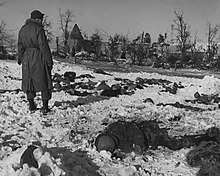
War crimes are serious violations of the rules of customary and treaty law concerning international humanitarian law that have become accepted as criminal offenses for which there is individual responsibility.[17] Colloquial definitions of war crime include violations of established protections of the laws of war, but also include failures to adhere to norms of procedure and rules of battle, such as attacking those displaying a peaceful flag of truce, or using that same flag as a ruse to mount an attack on enemy troops. The use of chemical and biological weapons in warfare are also prohibited by numerous chemical arms control agreements and the Biological Weapons Convention. Wearing enemy uniforms or civilian clothes to infiltrate enemy lines for espionage or sabotage missions is a legitimate ruse of war, though fighting in combat or assassinating individuals behind enemy lines while so disguised is not, as it constitutes unlawful perfidy.[18][19][20][21] Attacking enemy troops while they are being deployed by way of a parachute is not a war crime.[22] However, Protocol I, Article 42 of the Geneva Conventions explicitly forbids attacking parachutists who eject from disabled aircraft and surrendering parachutists once landed.[23] Article 30 of the 1907 Hague Convention IV – The Laws and Customs of War on Land explicitly prohibits belligerents to punish enemy spies without previous trial.[24]
The rule of war, also known as the Law of Armed Conflict, permit belligerents to engage in combat. A war crime occurs when superfluous injury or unnecessary suffering is inflicted upon an enemy.[25]
War crimes also include such acts as mistreatment of prisoners of war or civilians. War crimes are sometimes part of instances of mass murder and genocide though these crimes are more broadly covered under international humanitarian law described as crimes against humanity. In 2008, the U.N. Security Council adopted Resolution 1820, which noted that "rape and other forms of sexual violence can constitute war crimes, crimes against humanity or a constitutive act with respect to genocide"; see also war rape.[26] In 2016, the International Criminal Court convicted someone of sexual violence for the first time; specifically, they added rape to a war crimes conviction of Congo Vice President Jean-Pierre Bemba Gombo.[27]
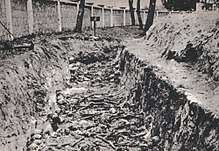
War crimes also included deliberate attacks on citizens and property of neutral states, such as the Japanese attack on Pearl Harbor. As the attack on Pearl Harbor happened while the U.S. and Japan were at peace and without a just cause for self-defense, the attack was declared by the Tokyo Trials to go beyond justification of military necessity and therefore constituted a war crime.[28][29][30]
War crimes are significant in international humanitarian law[31] because it is an area where international tribunals such as the Nuremberg Trials and Tokyo Trials have been convened. Recent examples are the International Criminal Tribunal for the Former Yugoslavia and the International Criminal Tribunal for Rwanda, which were established by the UN Security Council acting under Chapter VIII of the UN Charter.
Under the Nuremberg Principles, war crimes are different from crimes against peace. Crimes against peace include planning, preparing, initiating, or waging a war of aggression, or a war in violation of international treaties, agreements, or assurances. Because the definition of a state of "war" may be debated, the term "war crime" itself has seen different usage under different systems of international and military law. It has some degree of application outside of what some may consider to be a state of "war", but in areas where conflicts persist enough to constitute social instability.
The legalities of war have sometimes been accused of containing favoritism toward the winners ("Victor's justice"),[32] as some controversies have not been ruled as war crimes. Some examples include the Allies' destruction of Axis cities during World War II, such as the firebombing of Dresden, the Operation Meetinghouse raid on Tokyo (the most destructive single bombing raid in history), and the atomic bombings of Hiroshima and Nagasaki.[33] In regard to the strategic bombing during World War II, there was no international treaty or instrument protecting a civilian population specifically from attack by aircraft,[34] therefore the aerial attacks on civilians were not officially war crimes. The Allies at the trials in Nuremberg and Tokyo never prosecuted the Germans, including Luftwaffe commander-in-chief Hermann Göring, for the bombing raids on Warsaw, Rotterdam, and British cities during the Blitz as well as the indiscriminate attacks on Allied cities with V-1 flying bombs and V-2 rockets, nor the Japanese for the aerial attacks on crowded Chinese cities.[35] Although there are no treaties specific to aerial warfare,[34] Protocol 1, Article 51 of the Geneva Conventions explicitly prohibits the bombardment of cities where civilian population might be concentrated regardless of any method.[23] (see Aerial bombardment and international law).
Controversy arose when the Allies re-designated German POWs (under the protection of the 1929 Geneva Convention on Prisoners of War) as Disarmed Enemy Forces (allegedly unprotected by the 1929 Geneva Convention on Prisoners of War), many of which then were used for forced labor such as clearing minefields.[36] By December 1945, six months after the war had ended, it was estimated by French authorities that 2,000 German prisoners were still being killed or maimed each month in mine-clearing accidents.[36] The wording of the 1949 Third Geneva Convention was intentionally altered from that of the 1929 convention so that soldiers who "fall into the power" following surrender or mass capitulation of an enemy are now protected as well as those taken prisoner in the course of fighting.[37][38]
Legality of Civilian Casualties
Under the Law of Armed Conflict (LOAC), the death of non-combatants isn't necessarily a violation, there are many things to take into account. Civilians cannot be made the object of an attack, but the death/injury of civilians while conducting an attack on a military objective are governed under principles such as of proportionality and military necessity and can be permissible. Military necessity "permits the destruction of life of … persons whose destruction is incidentally unavoidable by the armed conflicts of the war; ... it does not permit the killing of innocent inhabitants for purposes of revenge or the satisfaction of a lust to kill. The destruction of property to be lawful must be imperatively demanded by the necessities of war"[39]
For example, conducting an operation on ammunition depot or a terrorist training camp would not be prohibited because a farmer is plowing a field in the area, the farmer is not the object of attack and the operations would adhere to proportionality and military necessity. On the other hand, an extraordinary military advantage would be necessary to justify an operation posing risks of collateral death or injury to thousands of civilians. In "grayer cases" the legal question of whether the expected incidental harm is excessive may be very subjective. For this reason, States have chosen to apply a "clearly excessive" standard for determining whether a criminal violation has occurred.[40]
When there is no justification for military action, such as civilians being made the object of attack, a proportionality analysis is unnecessary to conclude that the attack is unlawful.
International Criminal Tribunal for the former Yugoslavia
For aerial strikes, pilots generally have to rely on information supplied external sources (Headquarters, ground troops) that a specific position is in fact a military target. In the case of former Yugoslavia, NATO pilots hit a civilian object (United States bombing of the Chinese embassy in Belgrade) that was of no military significance, but the pilots had no idea of determining it aside from their orders. The committee ruled that "the aircrew involved in the attack should not be assigned any responsibility for the fact they were given the wrong target and that it is inappropriate to attempt to assign criminal responsibility for the incident to senior leaders because they were provided with wrong information by officials of another agency.".[41] The report also notes that "Much of the material submitted to the OTP consisted of reports that civilians had been killed, often inviting the conclusion to be drawn that crimes had therefore been committed. Collateral casualties to civilians and collateral damage to civilian objects can occur for a variety of reasons." [41]
Rendulic Rule
The Rendulic Rule is a standard by which commanders are judged.
German General Lothar Rendulic was charged for ordering extensive destruction of civilian buildings and lands while retreating a suspected enemy attack in what is called scorched earth policy for the military purpose of denying the use of ground for the enemy. He overestimated the perceived risk but argued that Hague IV authorized the destruction because it was necessary to war. He was acquitted of that charge.
Under the "Rendulic Rule" persons must assess the military necessity of an action based on the information available to them at that time; they cannot be judged based on information that subsequently comes to light.[40]
See also
Country listings
- List of war crimes
- 1971 Bangladesh atrocities
- Allied war crimes during World War II
- British war crimes
- German war crimes
- Consequences of German Nazism
- Holocaust
- War crimes of the Wehrmacht
- International Military Tribunal for the Far East
- Islamic State of Iraq and the Levant war crimes findings
- Italian war crimes
- Japanese war crimes
- Saudi Arabian-led intervention in Yemen
- Korean War crimes
- Soviet war crimes
- United States Senate Committee on the Philippines
- United States war crimes
Legal issues
- American Service-Members' Protection Act
- Command responsibility
- Law of war
- Rule of Law in Armed Conflicts Project (RULAC)
- Russell Tribunal
- Special Court for Sierra Leone
- The International Criminal Court and the 2003 invasion of Iraq
- War Crimes Law (Belgium)
- War Crimes Act of 1996 – incorporation of War Crimes into United States law
Miscellaneous
- Chronicles of Terror
- Civilian internee
- Commando order
- Commissar order
- Crimes against humanity
- Crime against peace
- Crime of aggression
- Doctors' Trial
- Forensic archaeology
- Human shield
- International Criminal Court investigations
- Katyn massacre
- List of denaturalized former citizens of the United States, including those denaturalized for concealing involvement in war crimes to obtain that country's citizenship
- Looting
- Mass Atrocity crimes
- Mass killing
- Military use of children
- Nazi human experimentation
- NKVD prisoner massacres
- No quarter
- Nuremberg Principles
- Perfidy
- Razakars (Pakistan)
- Satellite Sentinel Project
- Srebrenica massacre
- State terrorism
- Terror bombing
- Transitional justice
- Unlawful combatant
- Wartime sexual violence
- Winter Soldier Investigation
References
- Cassese, Antonio (2013). Cassese's International Criminal Law (3rd ed.). Oxford University Press. pp. 63–66. ISBN 978-0-19-969492-1. Archived from the original on April 29, 2016. Retrieved October 5, 2015.
- The evolution of individual criminal responsibility under international law Archived September 10, 2009, at the Wayback Machine By Edoardo Greppi, Associate Professor of International Law at the University of Turin, Italy, International Committee of the Red Cross No. 835, p. 531–553, October 30, 1999.
- highlights the first international war crimes tribunal by Linda Grant, Harvard Law Bulletin.
- "Convention for the Amelioration of the Condition of the Wounded and Sick in Armies in the Field. Geneva, 6 July 1906". International Committee of the Red Cross. Archived from the original on February 22, 2014. Retrieved July 20, 2013.
- "1949 Geneva Convention (I) for the Amelioration of the Condition of the Wounded and Sick in Armed Forces in the Field – Centre for International Law". nus.edu.sg. Archived from the original on February 21, 2014.
- David P. Forsythe (June 17, 2007). The International Committee of the Red Cross: A Neutral Humanitarian Actor. Routledge. p. 43. ISBN 978-0-415-34151-6.
- "Human Rights Watch: Saudi strikes in Yemen violated international law Archived July 22, 2015, at the Wayback Machine". Deutsche Welle. June 30, 2015.
- "Rome Statute of the International Criminal Court, 1998". UN Treaty Organization. Archived from the original on October 19, 2013. Retrieved October 13, 2010.
- "Ukraine: Unguided Rockets Killing Civilians Archived July 24, 2014, at the Wayback Machine". Human Rights Watch. July 24, 2014.
- "Rome Statute, Part II, Article 8". United Nations Office of Legal Affairs. Archived from the original on October 19, 2013. Retrieved October 18, 2013.
- "Decision on Motion for Judgement of Acquittal in the Milosevic Case | International Criminal Tribunal for the former Yugoslavia". Archived from the original on August 18, 2017. Retrieved August 17, 2017.
- "Trial of Charles Taylor ends – Europe". Al Jazeera English. Archived from the original on April 1, 2011. Retrieved May 2, 2012.
- "Radovan Karadzic, a Bosnian Serb, Gets 40 Years Over Genocide and War Crimes". The New York Times. Archived from the original on March 24, 2016. Retrieved March 24, 2016.
- "Karadzic sentenced to 40 years for genocide". CNN. Archived from the original on March 26, 2016. Retrieved March 26, 2016.
- "UN appeals court increases Radovan Karadzic's sentence to life imprisonment". Washington Post. Retrieved March 20, 2019.
- "BBC News – Ratko Mladic trial: Charge sheet amended – Brammertz". Bbc.co.uk. June 1, 2011. Archived from the original on February 24, 2012. Retrieved May 2, 2012.
- Shaw, M.N (2008). International Law. Cambridge University Press. pp. 433–434. ISBN 978-0-521-89929-1.
- Smith, Michael (2007). Killer Elite: The Inside Story of America's Most Secret Special Operations Team. New York, New York: St. Martin's Press. ISBN 978-0-312-36272-0.
- Beckwith, Charlie A.; Knox, Donald (2003). Delta Force: The Army's Elite Counterterrorist Unit. Avon. ISBN 978-0-380-80939-4.
- "United States of America, Practice Relating to Rule 65. Perfidy, Section I. Simulation of civilian status". International Red Cross. Archived from the original on September 26, 2013. Retrieved September 22, 2013.
- "United States of America, Practice Relating to Rule 62. Improper Use of Flags or Military Emblems, Insignia or Uniforms of the Adversary". International Red Cross. Archived from the original on September 26, 2013. Retrieved September 22, 2013.
- From the Library of Congress, Military Legal Resources. Archived December 18, 2017, at the Wayback Machine
- Protocol Additional to the Geneva Conventions of August 12, 1949, and relating to the Protection of Victims of International Armed Conflict, International Committee of the Red Cross, Geneva, Switzerland.(Protocol I) Archived December 10, 2008, at the Wayback Machine
- "Convention (IV) respecting the Laws and Customs of War on Land and its annex: Regulations concerning the Laws and Customs of War on Land. The Hague, 18 October 1907". International Committee of the Red Cross. Archived from the original on September 26, 2013. Retrieved July 24, 2013.
- Smith, S; Devine, M; Taddeo, J; McAlister, VC (2017). "Injury profile suffered by targets of antipersonnel improvised explosive devices: prospective cohort study". BMJ Open. 7 (7): e014697. doi:10.1136/bmjopen-2016-014697. PMC 5691184. PMID 28835410.
- "Security Council Demands Immediate and Complete Halt to Acts of Sexual Violence". un.org. Archived from the original on August 23, 2014. Retrieved June 29, 2017.
- Kevin Sieff (March 21, 2016). "In historic ruling, international court cites rape in war crimes conviction of ex-Congo official". Washington Post.
- Geoff Gilbert (September 30, 2006). Responding to International Crime (International Studies in Human Rights). p. 358. ISBN 978-90-04-15276-2.
- Yuma Totani (April 1, 2009). The Tokyo War Crimes Trial: The Pursuit of Justice in the Wake of World War II. Harvard University Asia Center. p. 57.
- Stephen C. McCaffrey (September 22, 2004). Understanding International Law. AuthorHouse. pp. 210–229.
- "The Program for Humanitarian Policy and Conflict Research, "Brief Primer on IHL"". Archived from the original on April 19, 2010.
- Zolo, Danilo (November 2, 2009). Victors' Justice: From Nuremberg to Baghdad. Verso. ISBN 978-1-84467-317-9.
- "The Atomic Bombing, The Tokyo War Crimes Tribunal and the Shimoda Case: Lessons for Anti-Nuclear Legal Movements by Yuki Tanaka and Richard Falk". Wagingpeace.org. Archived from the original on March 18, 2012. Retrieved May 2, 2012.
- Javier Guisández Gómez (June 30, 1998). "The Law of Air Warfare". International Review of the Red Cross (323): 347–363. Archived from the original on April 3, 2013. Retrieved June 21, 2013.
- Terror from the Sky: The Bombing of German Cities in World War II. Berghahn Books. 2010. p. 167. ISBN 978-1-84545-844-7.
- S. P. MacKenzie "The Treatment of Prisoners of War in World War II" The Journal of Modern History, Vol. 66, No. 3. (Sep. 1994), pp. 487–520.
- ICRC Commentaries on the Convention (III) relative to the Treatment of Prisoners of War Archived April 4, 2013, at the Wayback Machine Article 5 Archived October 23, 2013, at the Wayback Machine "One category of military personnel which was refused the advantages of the Convention in the course of the Second World War comprised German and Japanese troops who fell into enemy hands on the capitulation of their countries in 1945 (6). The German capitulation was both political, involving the dissolution of the Government, and military, whereas the Japanese capitulation was only military. Moreover, the situation was different since Germany was a party to the 1929 Convention and Japan was not. Nevertheless, the German and Japanese troops were considered as surrendered enemy personnel and were deprived of the protection provided by the 1929 Convention relative to the Treatment of Prisoners of War."
- ICRC Commentaries on the Convention (III) relative to the Treatment of Prisoners of War Archived April 4, 2013, at the Wayback Machine Article 5 Archived October 23, 2013, at the Wayback Machine "Under the present provision, the Convention applies to persons who "fall into the power" of the enemy. This term is also used in the opening sentence of Article 4, replacing the expression "captured" which was used in the 1929 Convention (Article 1). It indicates clearly that the treatment laid down by the Convention is applicable not only to military personnel taken prisoner in the course of fighting, but also to those who fall into the hands of the adversary following surrender or mass capitulation."
- Germany (Territory under Allied occupation, 1945–1955 : U.S. Zone) (1997). Trials of war criminals before the Nuernberg Military Tribunals under Control Council law no. 10, Nuremberg, October 1946-April, 1949. William S. Hein. ISBN 1575882159. OCLC 37718851.
- United States. Department of Defense. Office of General Counsel, author. Department of Defense law of war manual. OCLC 953877027.
- "Final Report to the Prosecutor by the Committee Established to Review the NATO Bombing Campaign Against the Federal Republic of Yugoslavia". International Criminal Tribunal for the former Yugoslavia.
Further reading
- Robert Cryer (2007). An introduction to international criminal law and procedure. Cambridge University Press. ISBN 978-0-521-87609-4.
- Yôrām Dinstein (2004). The conduct of hostilities under the law of international armed conflict. Cambridge University Press. ISBN 978-0-521-54227-2. Retrieved November 14, 2010.
- Hagopian, Patrick (2013). American Immunity: War Crimes and the Limits of International Law. Amherst, MA: University of Massachusetts Press.
- Horvitz, Leslie Alan; Catherwood, Christopher (2011). Encyclopedia of War Crimes & Genocide (Hardcover). 2 (Revised ed.). New York: Facts on File. ISBN 978-0-8160-8083-0. ISBN 0-8160-8083-6
- Malcolm N. Shaw (November 24, 2008). International law. Cambridge University Press. ISBN 978-0-521-72814-0. Retrieved November 14, 2010.
- Gary D. Solis (2010). The Law of Armed Conflict: International Humanitarian Law in War. Cambridge University Press. ISBN 978-0-521-87088-7. Retrieved November 14, 2010.
See also
- Crimes Against Humanity
- International Criminal Court
- Rome Statute of the International Criminal Court
- Rule of Law
External links
| Library resources about War crime |
| Wikimedia Commons has media related to War crimes. |
| Wikiquote has quotations related to: War crime |
- Australian Bunker And Military Museum - abmm.org
- "Amnesty International". Amnesty International. Retrieved July 29, 2015.
- "International criminal jurisdiction". International Committee of the Red Cross.
- "Cambodia Tribunal Monitor". Northwestern University School of Law Center for International Human Rights and Documentation Center of Cambodia. Retrieved December 17, 2008.
- Burns, John (January 30, 2008). "Quarter, Giving No". Crimes of War Project. Archived from the original on December 31, 2008. Retrieved December 17, 2008.
- War Crimes: Responsibility and the Psychology of Atrocity
- Human Rights First; Command's Responsibility: Detainee Deaths in U.S. Custody in Iraq and Afghanistan
- TheRule of Law in Armed Conflicts Project
- Iraqi Special Tribunal
- Crimes of War Project
- Rome Treaty of the International Criminal Court
- Special Court for Sierra Leone
- UN International Criminal Tribunal for the former Yugoslavia
- UN International Criminal Tribunal for Rwanda
- Ad-Hoc Court for East Timor
- CBC Digital Archives -Fleeing Justice: War Criminals in Canada
- A Criminological Analysis of the Invasion and Occupation of Iraq By Ronald C. Kramer and Raymond J. Michalowski
- Sri Lanka's Killing Fields: War Crimes Unpunished on YouTube
- Investigating Human Rights – Reaching Out to Diaspora Communities in U.S. for War Crimes Tips (FBI)
- UK's Geneva Conventions (Amendment) Act 1995 – which bans War Crimes